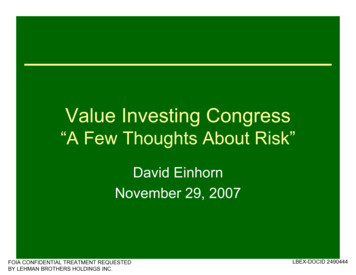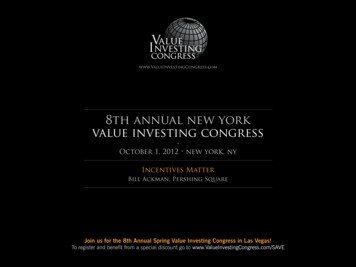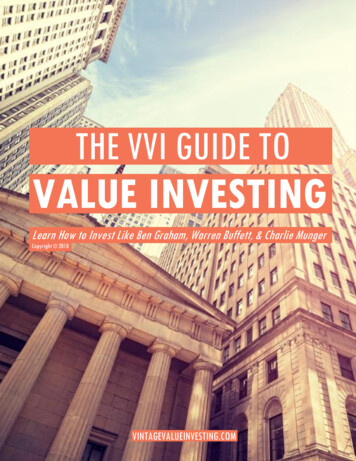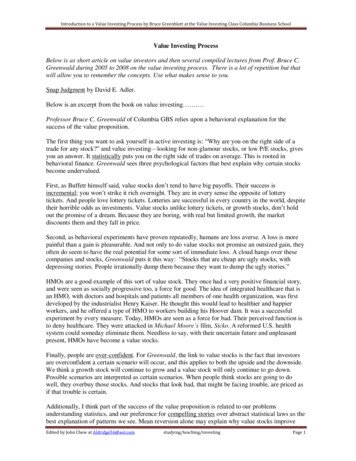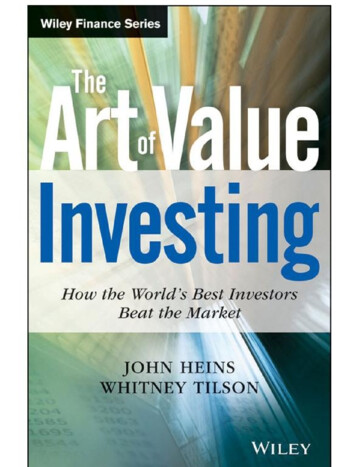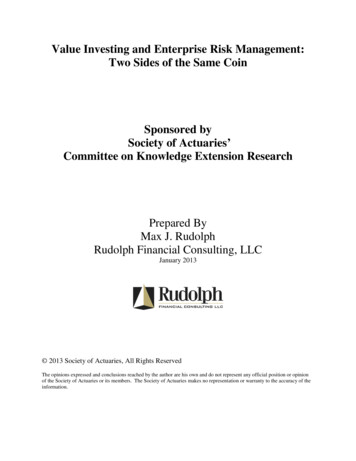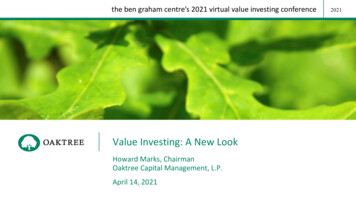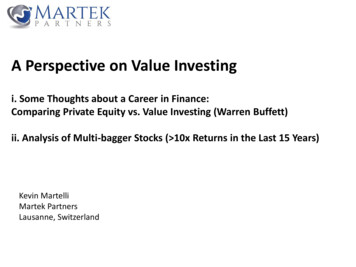
Transcription
A Perspective on Value Investingi. Some Thoughts about a Career in Finance:Comparing Private Equity vs. Value Investing (Warren Buffett)ii. Analysis of Multi-bagger Stocks ( 10x Returns in the Last 15 Years)Kevin MartelliMartek PartnersLausanne, Switzerland
Important Disclosure The present document has been prepared by Martek Partners SA with the purpose of sharinginformation about some of its general views on business analysis and financial markets. Unlessotherwise specifically stated, the information contained herein is made available only for theintended recipient, to which this presentation is addressed, for informational purposes only. The information contemplated herein will not represent by any means any offer, diligence orrecommendation to buy, sell or acquire any sort of securities or investment funds, norparticipating in any other operations, or providing any advising or investment service. It is notMartek Partners SA’s intention to provide clients investment advice of any kind. The informationcontained below shall not be used in isolation to formulate any investment decision nor interestof any other kind. Martek Partners SA recommends you to obtain advice on your investmentsfrom a different independent source. Should you have any inquiry regarding your investments,you should seek advice from an independent consultant. Martek Partners SA expressly declines all responsibility towards any person, action or omission,as well as the total or partial consequences derived from third parties, which may be based totalor partially on the contents of the present document and shall not be responsible for anydamage or prejudice derived from the use or consequence of the use of the informationcontained herein, including, with no constraints, any loss of benefit or any other direct orindirect prejudice.2
Key Questions1.2.3.4.What can be learned by studying how Warren Buffett turned 1,000 inBerkshire Hathaway into 18 million over 50 years (1964-2014)? Howreplicable is Buffett’s value investing approach today? And how does itcompare to private equity?In evaluating an investment, what are the factors and risks that need to beaddressed carefully?Is there a relationship between the volatility of a security and the risk ofpermanent loss of value?Why the concept of risk-return is very different if you change the time framefrom short-term (12 months) to long term (5-10 years)? Does it makes sense toevaluate investments with a 12-18 months time frame?3
Evolution of Warren Buffett’s Personal Net WorthData in USD000s (k)67 billion 70,000,000A unique story of long term value creation,very well described by Buffett and others59bn 60,000,000 50,000,000Many lessonsto be learned 40,000,00036bnSome additional facts:- Berkshire’s stock was down 50% from peak levels 3x during its history- Buffett in his shareholders’ letters tends to highlight his mistakes- Even minority shareholders would have achieved a return of 18,000x over50 years, assuming they held the shares 30,000,000 20,000,00017bn 10,000,0005k6k10k20k 140k1m 1.4m 2.4m14151921303.4m7m8m10m3435363725m 34m 19m1.4bn67m 376m 620m39472.3bn3.8bn 2632334344525356585966728385Age of Warren Buffett4
1. Some Thoughts about a Career in Finance:Comparing Private Equity vs. Value Investing(Warren Buffett)
A Few Words about my Career Background 2001-08Investment Banking at Rothschild (Milan) and Credit Suisse (Milan, London) 2008-12Investments Team at Exor (Turin), listed holding company 2013-17Worked mainly in mergers & acquisitions, but also got exposure to otherinvestment banking areas (e.g. equity capital markets, high yield, debtrestructuring) as well as different industries (e.g. media, telecom,consumer, industrial, banking, insurance)In 2006-07 I worked on several potential leveraged buyouts with privateequity clients in the media / yellow pages businessMember of the investment committee of JRE, a joint venture betweenJardine, Rothschild and Exor to make private equity investments in AsiaLaunched Martek Partners (Lausanne), advisor to an investment fund inpublicly listed companies with a long term value approach6
Comparing Private Equity vs. Buffett’s ApproachA very different approach to investments, risk-reward profile .and lifestylePrivate Equity ApproachWarren Buffett ApproachExtensive due diligence (2-3 monthsprocess), detailed business plans / excelmodelling. Private equity firms oftenparticipate in deal auctions, althoughthey try to avoid themPreference for influencing / improvingcompany performance also by changingmanagementLimited or no formal due diligence,No use of modelling / business plansFocuses on annual reports andmanagement track record. Buffett neverparticipates in deal auctionsAgnostic to company control / boardrepresentation. Buys only if existingmanagement stays in placeUse of LeverageExtensive use of debt leverageGenerally avoids use of debt leverageTime AllocationMany meetings with potential companytargets, management teams, bankers,consultants, etc.Spends most of his time reading,thinking, talking to few trustedpeople and playing bridgeReturns7-9% annual return on committedcapital(1) is considered quite good21.6% annual return from 1964 until2014Assessment ofInvestmentsOpportunitiesCompany Control /Mgmt. ChangeThe above considerations are based on my personal professional experience (in investment banking), of coursenot all private equity funds follow the same approach and also Buffett’s approach has partially changed overtime(1) Private equity returns are generally calculated on invested capital, not committed capital. Nevertheless from the point of view of a limited partner of a privateequity fund the return on committed capital is a better measure of the fund’s performance since any committed (but not yet invested) capital needs to be keptin liquid / low yielding financial instruments (such as govt. bonds), therefore affecting the overall performance of its committed capital to the fund7
Historical Returns: Berkshire vs. S&P 500From 1964 until 2014 the stock price of Berkshire Hathaway achieved 21.6% annualreturn vs. 9.9% of S&P 500 (US equity index)2014 Market Value of 1,000 invested in 1964 20,000,000 18,262,630 18,000,000An interesting paradoxThe greatest investment return of alltime has been achieved by one of themost cautious investors of all time 16,000,000 14,000,000On risk & volatility 12,000,000Most equity fundsunderperform 10,000,000Interestingly 80-90% ofinvestment funds fail to beat theS&P 500 over 5-10 year periods 8,000,000 6,000,000 Buffett stated thathe would muchrather earn alumpy 15% overtime than asmooth 12%BerkshireHathaway’s stockwas down 50% 3times in its history 4,000,000 2,000,000 112,960 -Berkshire HathawayCompounded annualreturn 1964-2014:21.6%S&P 5009.9%Source: Berkshire Hathaway 2014 annual report and SPIVA 2014 US Scorecard of investment funds8
A Few Quotes from Graham, Buffett and MungerBenjamin Graham on Value Investing and Margin of Safety “Price is what you pay. Value is what you get.” “The function of the margin of safety is, in essence, that of rendering unnecessary anaccurate estimate of the future.” “The intelligent investor is a realist who sells to optimists and buys from pessimists.”Warren Buffett on Risk “It seems, for whatever reason, that volatility is often synonymous with risk for mostpeople. I’ve never viewed it that way. Volatility has never been a proxy for risk,[.] WhenI think of risk, I think of permanent loss of capital.” “Risk comes from not knowing what you’re doing.” “Risk can be greatly reduced by concentrating on only a few holdings.”Charlie Munger on the Importance of Reading “In my whole life, I have known no wise people who didn't read all the time - none, zero.You'd be amazed at how much Warren reads - at how much I read.”9
Berkshire Hathaway’s Key Success Drivers1. Being a learning machine: Buffett spends 50% of his time reading. According to his businesspartner Charlie Munger “Warren [Buffett] is one of the best learning machines on this earth.[ ]. If you stop learning in this world, the world rushes right by you”2. Sticking to his "circle of competence": Buffett invests only in businesses he understands and isable to predict, avoiding industries that are too competitive or driven by disruptive innovation3. Focusing on long term investing and avoiding permanent loss of capital: Buffett is well knownto be indifferent to short term price volatility (which is effectively a measure of other investors’uncertainty regarding value), but is very much focused on avoiding permanent loss of capital4. Unique source of leverage through insurance “float”: Berkshire Hathaway invests thepremiums of its reinsurance and insurance companies, which effectively provide Berkshire witha permanent and extremely low-cost source of capital, referred by Buffett as the “float”5. Becoming the preferred buyer of companies: since Buffett, unlike private equity players, doesnot sell his majority-owned businesses, over time he has become the “preferred buyer” forowners who care about their business future prospects, even after they sell them10
Other Value Investors with Great Track RecordsWarren Buffett is not the only one to have achieved great long term returns, here aresome other examples of value investors to learn from Seth Klarman, Baupost Capital (investment focus: USA, Global) Mattias Westman, Prosperity Capital Management (investment focus: Russia) Chetan Parikh, Jeetay Investments (investment focus: India) Li Lu, Himalaya Capital (investment focus: Global) Lei Zhang, Hillhouse Capital (investment focus: China)11
Why Value Investing is not More Widespread?According to value investor Li Lu less of 5% of public equity investors can be considered “realvalue investors”. If over time value investing works why is it not more popular? Being a “rational contrarian” is tough (in any job .not just investing): as JM Keynes oncesaid: “Worldly wisdom teaches that it is better for reputation to fail conventionally than tosucceed unconventionally”. This is why most fund managers prefer to “follow the crowd”rather than trying to evaluate facts with good judgement and try to be right (e.g. techbubble in 2000 or subprime mortgage investments in 2006-07)– Continuous performance benchmarking (vs. indices and other fund managers) pushesinvestors to behave in a homogenous way, similarly to sardines’ "swarm behavior" infront of a shark predator The human brain is the result of millions of years of evolution and thus it is not necessarily“fit for decision making in complex/uncertain situations” (stock exchanges, globalization,technological disruption), which are a relatively recent phenomenon (say 40-50 years.)12
Technological Disruption & Value Investing1. Buffett succeeded by investing in businesses, which benefited from "gradual disruptions" (i.e.decades of 10-15% annual growth), thus more predictable– e.g. Wal-Mart, AmEx, Capital Cities/ABC2. In the last 10 years Internet and mobile computing have drastically accelerated the adoption rate ofnew technologies and new consumer habits (e.g. Facebook, Instagram, Google, Amazon, etc.)3. The acceleration of technological change in the last few years has reduced the share of "easy topredict" companies, which are not subject to tecnological obsolescence4. Ironically, in some cases it is becoming more risky to bet that things will stay the same (Buffett’straditional approach) vs. assuming that significant change will take place (venture capital approach)
On the Importance of a Long Term PerspectiveTry to estimate the long term returns of these investmentsStocks / Bonds / Equity IndicesEntryDateExitDate PerformanceUniCredit (main European bank)Apr-2007 Apr-2014Deutsche Telecom (German telecom company)Mar-2000 Apr-2014General Electric (industrial conglomerate)Aug-2000 Apr-2014Coca Cola (leading consumer brand)Greek Government BondsJul-1998 Apr-201420082012Nestle Pakistan in USDSep-2001 Apr-2014Russian equity index in USDOct-1998 Apr-2014Italian equity index in USD19481962American Express (leading credit card company)Mar-2009 Apr-2014McGraw Hill (leading rating agency)Jun-2010 Apr-201414
On the Importance of a Long Term PerspectiveAnd here are the answers, not always so obvious ."Blue chip" and government bonds investments generally considered safethat over time ended up being not so safeStocksUniCredit (European bank)EntryExitDateDate Performance Market perception at entry dateApr-2007 Apr-2014-90% Solid and well managed bank with pan-european ambitionsDeutsche Telekom (German telecom company)Mar-2000 Apr-2014General Electric (industrial conglomerate)Aug-2000 Apr-2014Coca Cola (leading consumer brand)Jul-1998 Apr-2014-88% Large player in fast growing Internet/telecom sector-57% One of the best managed industrial conglomerates globally-9% Dominant player in beverages, with growth potential in emerging marketsBondsGreek Government20082012-76% Safe government bonds, with better yield vs. other EU government bondsInvestments perceived to be too risky that ended up offering exceptional long term returnsStocks / Equity IndicesNestle Pakistan in USDEntryExitDateDate Performance Market perception at entry dateSep-2001 Apr-201438.4x Great company, but country is too risky due to political uncertaintyRussian Equity Index in USDOct-1998 Apr-2014Italian Equity Index in USD19481962American ExpressMar-2009 Apr-2014McGraw Hill (owner of S&P rating agency)Jun-2010 Apr-201428.7x10.0x7.2x2.7xBankrupt state with no future, simply too riskyItalian democracy after WWII was too politically unstableToo risky due to losses on consumer credit and liquidity issuesBroken business model due to regulatory uncertainty and lawsuitsThere can be a wide discrepancy between (i) the short term marketperception of risk and (ii) the long term performance of an investment.The risk-return profile of an asset is complex, not always well assessed by themar
Technological Disruption & Value Investing 1. Buffett succeeded by investing in businesses, which benefited from "gradual disruptions" (i.e. decades of 10-15% annual growth), thus more predictable–e.g. Wal-Mart, AmEx, Capital Cities/ABC 2. In the last 10 years Internet and mobile computing have drastically accelerated the adoption rate of




